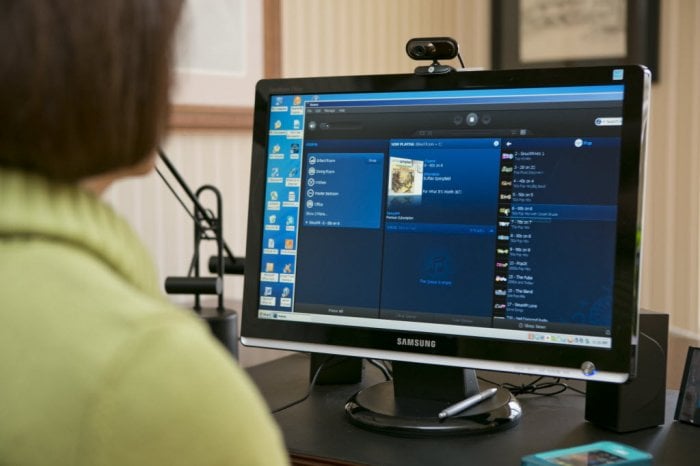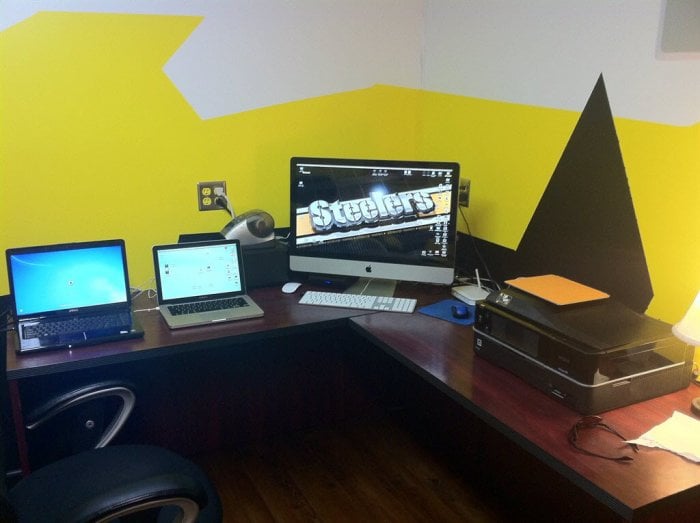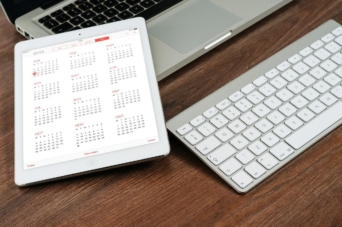First, you need to identify what you are primarily going to be using this computer for and how it will fit into your lifestyle. Do you plan to exclusively use your computer at home or do you need to keep your device with you? Does it need to be high powered or will something more simple do? How much customization or upgrading would you want to do? At most basic, computing devices can be separated into two categories of desktop and portable. Here is a quick breakdown of six types of computer you can purchase today:
• Tablets: Small, highly-portable touchscreen devices that use mini-programs called apps rather than traditional software packages. This makes them generally less powered for heavy computer use such as video editing, but great for watching videos, taking notes in small spaces, playing simple games and a wide variety of other functions.
• Netbooks: Best for Internet browsing, netbooks are small, low-powered laptops with screens measuring around ten inches. Very light and portable, they are also cheap, but you give up the power to run demanding programs and the ability to play disks as the optical drive is generally left out to save space.
• Laptops or Notebooks: These computers are a portable all-in-one machine that comes in a wide variety of options for price, size, weight, style and specifications. Notebooks are generally where portability, power and price are best aligned.
• Ultrabooks: Meticulously designed to be slimmer and lighter than standard laptops, ultrabooks come with a similar range of options and abilities as typical laptops. The price is higher, though, for the smaller size.
• Tower-style desktops: This computer system separates out the processor tower, monitor and other components into distinct units, making it the most customizable option. Generally, you get the most computer power for your dollar in a desktop, but it is conversely not easy to take with you.
• All-in-one desktops: These systems combine the processor, monitor and internal components into one compact unit. Aesthetically pleasing and free of tangles of cords under your desk, all-in-ones make the buying process simple by packaging everything you need together.

Understanding computer features
Once you’ve settled on a computer style, you need to decide how you will be using this computer; for web browsing, image editing, DVD watching, plenty of text typing, heavy gaming, video editing? All these pursuits require different levels of power in a machine. Before you buy, consider major aspects of a computer:
Operating system (OS): Arguably the biggest decision you have to make about your new device is what operating system it will run on. For traditional computers, your main choice will be between Microsoft Windows and Apple Mac OS, though Google’s Chrome OS is gaining traction in the marketplace and, for the technically savvy, so is Linux. If you find a tablet fits your needs, your big options are Android, Windows or iOS.
The main difference between the operating systems is style, but feelings can run strongly for each choice. Spend some time talking to friends and others, read online information and compare features and costs, but what will be probably most helpful is to go to a store and try them out for yourself to see what feels most natural to you. The other important factor in choosing an operating system is which programs or apps you are already using or plan to use as not all operating systems support all apps and programs.
Computer processing unit (CPU): Considered the brains of the machine, the CPU directly relates to the speed of the computer. When talking about processors, you will hear them defined in terms of cores and gigahertz (GHz) and generally the higher the number, the faster your computer will be. Most computer users will find a dual core processor sufficient but more demanding users such as video editors or heavy gamers will want a quad core or even a six core processor.
Random access memory (RAM): RAM is the space your computer uses to run programs and store data you are currently working on. The more RAM you have, the more tasks your computer can do at once and the faster is can perform tasks. Not enough RAM will lead to freeze ups and slow program loading. While RAM can usually be updated later in a laptop or desktop, it is most cost effective to buy enough RAM built-in.
RAM isn’t really a consideration when purchasing a tablet as there currently aren’t different RAM options offered.
Storage memory: If you will primarily be using your device for web browsing, emailing and other light tasks, you won’t need much storage memory, but if you plan to store plenty of music, photos or videos, be sure your device has enough gigabytes to accommodate you. This is a particularly important decision for tablets as their storage capacity is virtually impossible to upgrade. Laptops and desktops are usually upgradable either by completely replacing a hard drive or simply connecting an external hard drive for extra space.
Screen size: Larger screens may reduce eye strain and time spent scrolling, but the decision is strictly personal and depends on your needs for use and portability. With tablet screens starting at seven inches and computer monitors reaching upwards of 22 inches, you have plenty of options to consider. If you are interested in a monitor above 22 inches, you might consider purchasing a TV instead as it can perform the same function.
It is important to note for laptops and netbooks, screen size directly corresponds to keyboard size. Large hands will find small keyboards cramped for heavy typing tasks.
Power usage and battery life: If you plan to often need to work on your device away from power outlets, it is important to compare battery life. A computer’s rated battery life is often best-case-scenario, so be sure to read reviews from users for a more realistic idea of how long a laptop or tablet can last on a charge.
Though usually less of a consideration for desktop computers, you can compare models for energy efficiency and how they will impact your electric bill.
Ports: You will most likely want the ability to plug things into your device and so it is important to familiarize yourself with which ports you’re likely to use and make sure your new computer has them.
• USB: The most common connector; it’s always nice to have several. Used for peripherals such a mice, keyboards, hard drives, flash drives, etc.
• HDMI: Allows you to hook a cable to play audio and video on a TV or monitor.
• SD card readers: Cameras, e-readers and even tablets commonly store data on SD cards.
• Bluetooth: Not a physical port, but bluetooth is how many wireless peripherals like mice, keyboards or speakers can connect to your device.
Other features: Depending on specific uses you have in mind for your device, you might also want to pay close attention to the availability and quality of other features such as optical drive to read and write CDs and DVDS, speakers, onboard camera, graphics card and wireless network card.
Warranty: Your computer will probably come with a limited manufacturer’s warranty lasting 30-90 days, but you’ll surely be offered the chance to buy an extended warranty or service plan. It is a personal decision whether to purchase the extra warranty, but be sure you know fully what any extended warranty or service plan will and will not cover before you purchase anything because sometimes the plans are so limited, it’s unlikely you will even be able to use them. Don’t just take the salesperson’s word for it, but ask for a written description you can read over and refer to later if there are discrepancies when you try to get service.
Generally, the more you invested originally in the device, the more likely the warranty will be worth it, but if it was a cheaper device or something you know you will upgrade quickly anyway, the cost of repairs would not be detrimental down the road so buying a warranty now isn’t worth it. In the end, if you feel more peace of mind with an extended warranty, go ahead and get it.
Read more about extended warranties for electronics.
Identifying computer problems
Whenever your computerized device acts up, first isolate the problem as specifically as you can so you can perform effective troubleshooting on your own. You’ll also save time and money if you have a good idea of what caused the problem in the first place if you end up needing to call tech support or a computer repair technician.
All computer problems fall into one of two general categories: hardware problems and software problems. It may be tricky as some malfunctions could be caused by problems from either camp, but step one is always trying to identify which you are dealing with. Hardware problems are usually easier to isolate, but they cost more to repair. Software issues are harder to isolate, but they often cost less due to the lack of physical labor involved with making the repair.
Hardware Problems
A hardware problem is something that is directly related to the physical system; for example, if there’s no image on the display, the computer simply refuses to power on, the monitor displays odd colors after start up or the keyboard doesn’t work.
Basic steps to identify and/or solve the problem:
• Is your device plugged into a working outlet?
• Is everything turned on? If something seems to be not working, make sure the brightness is up or the volume unmuted or the on switch is in the appropriate position depending on what you are having issues with.
• Is your mouse, keyboard, speakers, monitor, etc plugged in to your device? Did you try a different port, if one is available, to see if it is the port or the device that is damaged?
Software Problems
Software problems usually manifest after the booting process. Having an unresponsive operating system or applications that no longer work properly is clear evidence of a software problem.
Basic steps to identify and/or solve the problem:
• Did you try a quick reboot?
• Are all your programs updated?
• Is your antivirus software running?
• Has your computer started acting up after a new program was installed? Try removing that program.
• Have you tried uninstalling and reinstalling a program that has suddenly started malfunctioning?
There is also plenty of help to be found around the Internet if you like to fix problems yourself, but be very cautious of more complicated repairs that take you into depths of your computer you are not familiar with. Computer users can inadvertently cause more and larger problems when interacting with system files or other important software components.
As you are trying to identify the problem with your device, it is a smart idea to take notes. Write down exactly what the computer is doing, and not doing, as well as any specific error codes that may come up. You should also take notes of what you do to try to fix the problem and the effects. This will help you, when you can’t remember what you have already tried, but it will definitely make the repair process easier if you find you need to hand off your device to a qualified computer repair technician.

There are many different options to consider if you have a laptop or desktop computer that needs repair.
How to find computer repair services
There are plenty of repair services out there; however, figuring out the best one for your specific problem can be difficult. If you are a member of Angie’s List, you can search the Computer Repair category for computer repair shops in your town.
If you aren’t satisfied with the options in your local area, another option is to hire an online repair service. These companies offer live, online support to diagnose and fix computer problems. In some ways, they resemble tech support. With these services, you usually prepay a certain amount of money for a remote investigation or chat with an off-site technician. During this discussion, the technician will diagnose your computer’s problem and offer a solution, if possible.
The problem with online repair services is that they work only if the caller is somewhat versed in computer terms and software design. If you don’t feel comfortable taking directions from a remote technician or giving remote control to one, online services can be a waste of time and money.
Local repair services often have a physical shop nearby, and many will come to your home to identify and fix a problem. These services are beneficial because the technician can physically examine your computer, and correct multiple problems if needed. It’s also easier to investigate the company’s background if they have a physical address and storefront.
It may be difficult to decide whether to repair or replace your computer when problems begin to arise, but it rarely hurts to take your computer to a reputable repair service for consultation. Many problems are fixable and with simple repair and/or upgrades, your computer could have a new lease on life.
Professional technicians can diagnose, repair, upgrade and offer expert advice. Due to vast experience and knowledge, a technician will most likely to be able to identify problems with your machine and repair them quicker and more efficiently that you could.
Viruses are the most common reason people seek computer repair services. Signs that a computer has a virus include slow performance, inability to launch programs or unfamiliar programs launching independently. Early detection is key. Consult with a computer repair technician to find out what can be done. The fact is, the technician has probably seen the problem before and can have the computer up and running again quickly.
Other services of computer technicians include:
• Replacing broken parts of hardware.
• Fixing glitches in software.
• Upgrading components, such as adding a larger hard drive or more RAM, to help a computer work at a higher level.
• Recovering data. Even if the computer itself cannot be repaired, technicians can often retrieve data from a broken or failing hard drive.
7 Computer Maintenance Tips
Proper maintenance will keep a home computer running well. A few minutes spent on tests and updates can avert frustrating crashes and sluggish performance.
Follow these computer maintenance tips:
1. Install antivirus security software and set up a regular sweep. Your computer may have come with a pre-installed antivirus system, but be sure you have one and it is set up to regularly search for and destroy malware on your machine. There are plenty of quality free programs such as AVG, Avast or Avira available if you need them, but no matter what, it is vital to protect your computer against viruses.
2. Consistently back up stored data and create restore points. Be prepared for the worst by regularly backing up your files on the hard drive or an external hard drive to be extra safe. It is likely that your computer came with a program to create system restore points (System Restore on Windows computers and Time Machine on Macs) that save a complete version of your computer that you can return to later. This is very helpful if a virus has completely ruined your machine and you can’t find out how to get rid of it. You simply go back to before the virus was introduced. Be sure to set up the programs to automatically create regular restore points or you can install third party programs to do this as well.
3. Keep your system and programs updated. Software developers regularly put out updates for everything from your operating system to programs you use regularly. These updates make sure your software is running top notch, but updates also regularly plug security holes so you will want to install updates as soon as you are notified of them to protect yourself against malicious viruses and spyware.
4. Uninstall unused programs and files and regularly defragment your hard drive to keep your computer from slowing down. The more free space your computer has on the hard drive, the faster it will run so if you have old files you don’t need or old programs you don’t use, clear them out. You will also want to regularly do a disk cleanup to clear out junk files that get downloaded by your browser or temporary program files that take up space. Also, regularly defragmenting your hard drive will keep your computer running smoothly. Your computer likely has a tool you can use to set up a routine defragmentation.
5. Practice safe browsing habits to avoid viruses and phishing scams. Much of the malicious software that wrecks computers finds its way to your device through your own unknowing clicking. Protect yourself by always reading the web address before you click a link in a search result, never clicking through on a suspicious popup window, never giving out login information even if the requester claims to be from a reputable company and never opening an email or email attachment you are unsure of.
6. Clean out dust and grime that accumulates outside and inside the machine. Built up dust can cause overheating and is to blame for lots of computer breakdowns. This is simple to avoid by regularly using a small vacuum to remove dust and then spray with compressed canned air. For tower-style desktops, you will want to remove the side panel to carefully clear the dust inside the tower every three to six months for optimum performance.
7. Plug your desktop into a surge protector. Electric storms can irreparably damage sensitive components inside your computer. The simplest way to protect it from power surges is to plug it into a surge protector.


